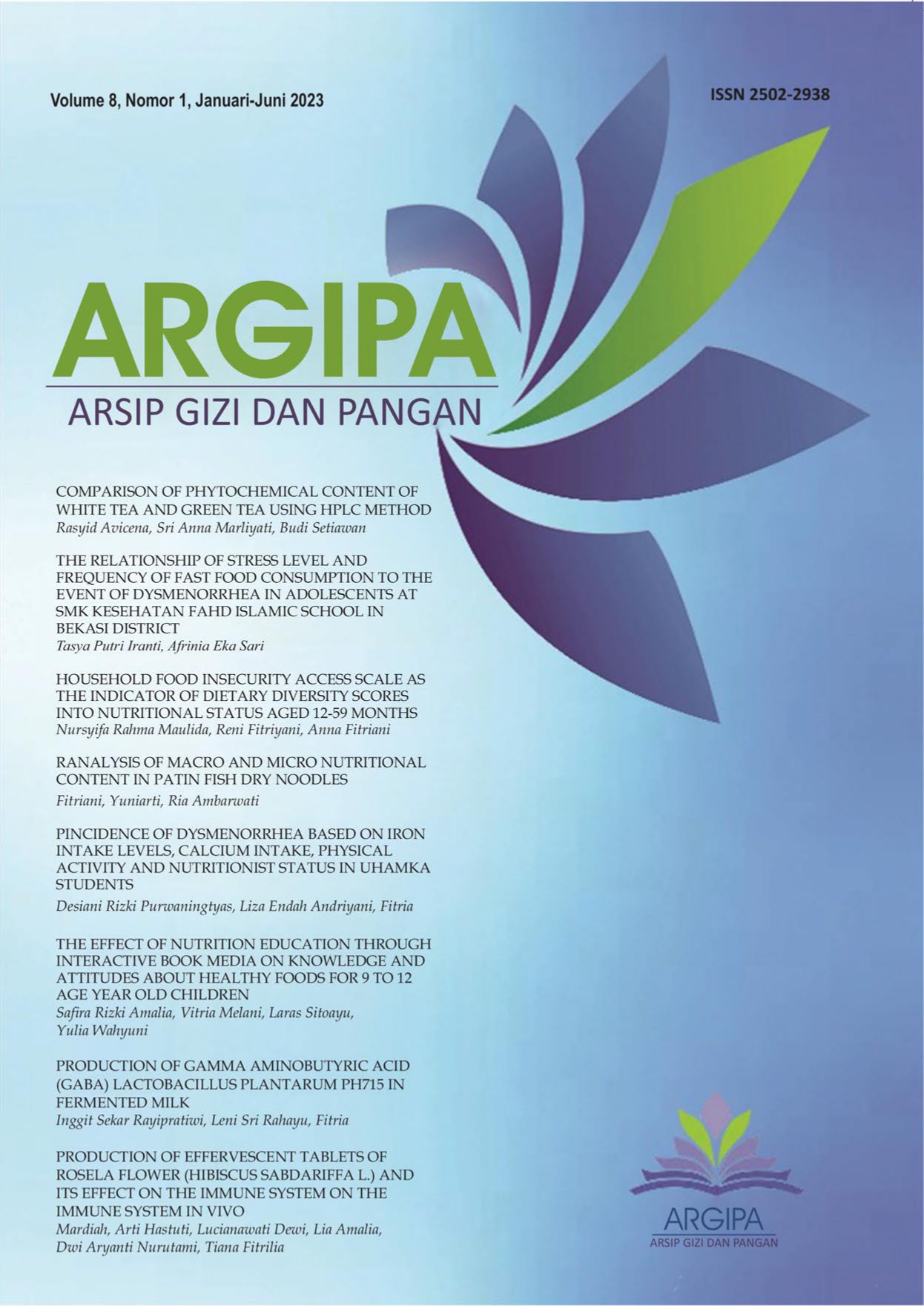Comparison of phytochemical content of white tea and green tea using HPLC method
DOI:
https://doi.org/10.22236/argipa.v8i1.11113Keywords:
EGCG, HPLC, Katekin, Teh Hijau, Teh PutihAbstract
Tea or Camellia sinensis is reported to contain as many as 4000 bioactive components, one of third are polyphenols. Polyphenols found in tea or Camellia sinensis are catechins, which consist of several types, one of which is Epigallocathecin-3-gallate (EGCG). Assessment of catechin and EGCG levels using HPLC due to considerations of efficiency, speed, and reduction of analysis costs which are also characteristic of HPLC. The aim of this study was to determine and compare the phytochemical content of catechin and EGCG compounds in white and green tea using the HPLC method. The research design used was a comparative analytical design. The main materials used were white tea and green tea from the Tea and Kina Research Center (PPTK), Gambung. The test conducted was a phytochemical examination of catechins and EGCG of white and green tea using the HPLC method in two replication. The results showed that the average catechin content in white tea was greater than that in green tea, which is 2.057±0,12% (w/b) in white tea, and 1.328±0,03% (w/b) in green tea. EGCG content in white tea has an average of 9.349±0,09% (w/b) and is greater than the average EGCG content in green tea which is only 8.037±0,05% (w/b). This is also reinforced by the statistical analysis results using an independent sample t-test of catechin and EGCG content in white and green tea which showed a significant difference. The conclusion is white tea has a greater catechin and EGCG content compared to green tea.
Downloads
References
Adnan, M.; Ahmad, A.; Ahmed, D.A.; Khalid, N.; Hayat, I.; Ahmed, I. (2013). Chemical Composition and Sensory Evaluation of Tea (Camellia Sinensis) Commercialized in Pakistan. Pak. J. Bot. 45:901–907.
Anand, et al. (2017). Therapeutic Potential of Epigallocatechin Gallate. International Journal of Green Pharmacy. 11(3): S364–70.
Anjarsari, I. R. D. (2016). Katekin Teh Indonesia : Prospek dan Manfaatnya. Kultivasi. 15(2): 99–106.
Behnoush, B., Sheikhazadi, A., Bazmi, E., Fattahi, A., Sheikhazadi, E., & Anary, S. H. S. (2015). Comparison of UHPLC and HPLC in Benzodiazepines Analysis of Postmortem Samples: A Case–Control Study. Medicine, 94(14): 1-7.
Chakrawarti, L., Agrawal, R., Dang, S., Gupta, S., & Gabrani, R. (2016). Therapeutic effects of EGCG: a patent review. Expert Opinion on Therapeutic Patents, 26(8), 907-916.
Chawla, G., & Ranjan, C. (2016). Principle, Instrumentation, And Applications Of UPLC: A ovel Technique of Liquid chromatography. Open Chemistry Journal, 3(1): 1-16.
Chu, C., Deng, J., Man, Y., & Qu, Y. (2017). Green tea extracts epigallocatechin-3-gallate for different treatments. BioMed research international, 2017.
Dias TR, Tomas G, Teixeira NF, Alves MG, Oliveira PF, Silva BM. (2013). White tea (Camellia sinensis l.): antioxidant properties and beneficial health effects. IJFS. 2(2):1-16.
Fajar, Luh Putu Wrasiati, dan Lutfi Suhendra. (2018). Kandungan Senyawa Flavonoid dan Aktivitas Antioksidan Ekstrak Teh Hijau pada Perlakuan Suhu Awal dan Lama Penyeduhan. Rekayasa dan Manajemen Agroindustri. 6(3): 196–202.
Farooq, S.; Sehgal, A. (2018). Antioxidant Activity of Different Forms of Green Tea: Loose Leaf, Bagged and Matcha. Curr. Res. Nutr. Food Sci. J. 6,35–40.
Franks, Melanie, Peter Lawrence, Alireza Abbaspourrad, dan Robin Dando. (2019). The Influence of Water Composition on Flavor and Nutrient Extraction in Green and Black Tea. Nutrients. 11(1).
Fu Qy, et all. (2017). Antidiabetic effect of tea. Molecules. 22(5):849.
Hamid F.S., Ahmad T, Waheed A, Ahmad N and S. Aslam. (2014). Effect of Different Levels of Nitrogen on the Chemical Composition of Tea (C. sinensis L.) grown at higher altitude. J. Mater. Environ. Sci. 5 (1) : 73-80.
Handayani, H., F.H. Srihefyna dan Yunianta. (2016). Ekstraksi antioksidan daun sirsak metode ultrasonic bath (kajian rasio bahan: pelarut dan lama ekstraksi). Jurnal Pangan dan Agroindustri. 4(1):262-272.
Huang, J.; Wang, Y.; Xie, Z.; Zhou, Y.; Zhang, Y.; Wan, X. (2014). The anti-obesity effects of green tea in human intervention and basic molecular studies. Eur. J. Clin. Nutr. 68, 1075–1087.
Indarti, D. (2015). Outlook Teh. Sekretariat Jenderal Kementeriaan Pertanian Pusat Data dan Sistem Informasi Pertanian. Dari http://epublikasi.setjen.pertanian.go.id/. Diakses 2 Februari 2023.
Karak T, Kutu FR, Nath JR, Sonar I, Paul RK, Boruah RK et al. (2017). Micronutrients (B, Co, Cu, Fe, Mn, Mo, and Zn) content in made tea (Camellia sinensis L.) and tea infusion with health prospect: A critical review. Crit Rev Food Sci Nutr. 57:2996-3034.
Lee, Lan Sook, Sang Hee Kim, Young Boong Kim, dan Young Chan Kim. (2014). Quantitative Analysis of Major Constituents in Green Tea with Different Plucking Periods and Their Antioxidant Activity. Molecules. 19(7): 9173–86.
Li. F, Wang. Y, Li. D, Chen. Y, Qiao. X, Fardous. R, et al. (2018). Perspectives on the recent developments with green tea polyphenols in drug discovery. Expert Opin. Drug Discov. 24, 1–18.
Mao, X.; Gu, C.; Chen, D.; Yu, B.; He, J. (2017). Oxidative stress-induced diseases and tea polyphenols. Oncotarget. 8, 81649–81661.
Mielgo-Ayuso J, Barrenechea L, Alcorta P, Larrarte E, Margareto J, Labayen I. (2014). Effects of dietary supplementation with epigallocatechin-3-gallate on weight loss, energy homeostasis, cardiometabolic risk factors and liver function in obese women: randomised, double blind, placebo-controlled clinical trial. Br J Nutr. 111: 1263-1271.
Mondal, Mrinmoy, dan Sirshendu De. (2018). Enrichment of (−) Epigallocatechin Gallate (EGCG) from Aqueous Extract of Green Tea Leaves by Hollow Fiber Microfiltration: Modeling of Flux Decline and Identification of Optimum Operating Conditions. Separation and Purification Technology. 206(5): 107–17.
Paramita, N. L.P.V, et al. (2019). Karakteristik Simplisia Teh Hitam dari Tanaman Camelia sinensis Var. Assamica dari Perkebunan Teh Bali Cahaya Amerta, Desa Angseri, Kecamatan Baturiti, Kabupaten Tabanan, Bali. Jurnal Kimia. 13(1): 58–66.
Pastoriza, S., Mesias, M., Cabrera, C., & Rufian-Henares, J. A. (2017). Healthy properties of green and white tea: an update. Food & function, 8(8): 2650-2662.
Purwanti, Leni, Undang Ahmad Dasuki, dan Allysa Rachma Imawan. (2019). Perbandingan Aktivitas Antioksidan dari Seduhan 3 Merk Teh Hitam (Camellia sinensis (L.) Kuntze) dengan Metode Seduhan Berdasarkan SNI 01-1902-1995. Jurnal Ilmiah Farmasi Farmasyifa. 2(1): 19–25.
Rabbani, Hanifah Ridha, Djoko Agus Purwanto, dan Isnaeni. (2019). Effect of Guava Powder Addition on Epigallocatechin Gallate (EGCG) Content of Green Tea and Its Antioxidant Activity. Jurnal Farmasi dan Ilmu Kefarmasian Indonesia. 6(2): 85–89
Sudaryat, Y, Mi Kusmiyati, CiR Pelangi, dan A Rustamsyah. (2015). Aktivitas Antioksidan Seduhan Sepuluh Jenis Mutu Teh Hitam (Camellia sinensis (L) O .Kuntze) Indonesia. Jurnal Penelitiaan Teh dan Kina. 18(2): 95– 100.
Silvester AJ, Aseer KR, Yun JW. (2019). Dietary polyphenols and their roles in fat browning. J Nutr Biochem. 64: 1-12.
Yang CS, Wang H, Sheridan ZP. (2018). Studies on prevention of obesity, metabolic syndrome, diabetes, cardiovascular diseases and cancer by tea. J Food Drug Anal. 26: 1-13.
Yu, Y.; Deng, Y.; Lu, B.M.; Liu, Y.X.; Li, J.; Bao, J.K. (2013). Green tea catechins: A fresh flavor to anticancer therapy. Apoptosis. 19, 1–18.
Wierzejska, R. (2014). Tea and health—A review of the current state of knowledge. Przegl. Epidemiol. 68, 595–599.

















